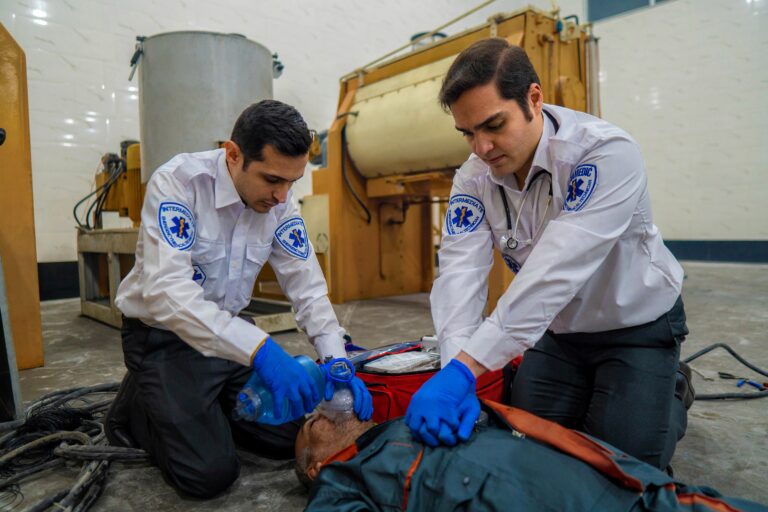Ileria CPR Feedback Device:Your Smart Guide to CPR Training
Welcome! Here, you’ll explore the core details of your smart training tool, including its physical features, precise technical specifications, and what comes in the box, helping you understand the product itself. Remember, this device is designed exclusively to help you master effective CPR techniques on manikins, guiding your training with accurate data and insights.
Every second counts while doing cardiopulmonary resuscitation (CPR), and the effectiveness of compressions can save lives. The Ileria CPR feedback monitor becomes a valuable companion in this situation. We will dive into the world of CPR, clarify the vital role the Ileria CPR feedback device plays in enhancing CPR effectiveness, address common questions, and highlight special features that make our CPR feedback device stand out from the competition in this extensive guide, so you have all the information you need to make an informed decision.
Every second counts while doing cardiopulmonary resuscitation (CPR), and the effectiveness of compressions can save lives. The Ileria CPR feedback monitor becomes a valuable companion in this situation. We will dive into the world of CPR, clarify the vital role the Ileria CPR feedback device plays in enhancing CPR effectiveness, address common questions, and highlight special features that make our CPR feedback device stand out from the competition in this extensive guide, so you have all the information you need to make an informed decision.
The Ileria CPR Feedback Device is SOLELY A TRAINING TOOL and is NOT designed for use on humans. It is intended for use only with CPR manikins under the guidance of a trainer. Misuse of this device on real persons can lead to incorrect treatment, serious injury, or death. Please use this device strictly for educational and training purposes.

When a person’s breathing or heartbeat stops, CPR is an emergency medical treatment used to keep oxygenated blood flowing to the brain. In order to manually pump the heart, it entails regular chest compressions and mechanical ventilation to supply oxygen to the lungs. The purpose of this feedback system is to help those who have never performed CPR before, as well as experts, do effective chest compressions without the risks related to the Automated CPR Machines.
Visual Depth Indicator
The Ileria compression feedback technology is designed to assist you in precisely compressing a victim to the necessary 5-centimeter (2 inches) depth for effective CPR. A visible depth indication on the device gives you instant visual signals to help you steer your compression depth. The Ileria CPR feedback device shows the exact compression depth when you are performing CPR, meaning that you are pushing within the permitted range.


The Ileria compression feedback technology is designed to assist you in precisely compressing a victim to the necessary 5-centimeter (2 inches) depth for effective CPR. A visible depth indication on the device gives you instant visual signals to help you steer your compression depth. The Ileria CPR feedback device shows the exact compression depth when you are performing CPR, meaning that you are pushing within the permitted range.


Audio-Visual rate indicator

The Ileria training aid incorporates a Visual Rate Indicator designed to enhance rhythm accuracy during CPR. This innovative addition includes a speedometer with a dynamic indicator that visually represents the compression rate. For compression rates within the normal range, specifically between 100 and 120 compressions per minute, the indicator remains centered in the middle part or green zone. When the compression rate falls below the optimal range, the indicator shifts to the left, similar to the display on a car amp, signaling that adjustments need to be made to achieve the recommended rate. Conversely, if the compression rate exceeds the optimal range, the indicator moves to the right, providing a clear visual cue that the rate is too fast and prompting the CPR performer to moderate their efforts.

The Ileria training aid incorporates a Visual Rate Indicator designed to enhance rhythm accuracy during CPR. This innovative addition includes a speedometer with a dynamic indicator that visually represents the compression rate. For compression rates within the normal range, specifically between 100 and 120 compressions per minute, the indicator remains centered in the middle part or green zone. When the compression rate falls below the optimal range, the indicator shifts to the left, similar to the display on a car amp, signaling that adjustments need to be made to achieve the recommended rate. Conversely, if the compression rate exceeds the optimal range, the indicator moves to the right, providing a clear visual cue that the rate is too fast and prompting the CPR performer to moderate their efforts.
Based on your feedback, we found that it is hard to keep the eyes on both the Depth and Rate indicators simultaneously in stressful situations. Then this CPR assistant becomes like a Dragon Boat Drummer, with its audio rhythm alarm. It helps you to ensure recoiling and delivering the oxygenated blood to the brain, buying time for defibrillation before the brain dies, just by following the sound it produces for you
Based on your feedback, we found that it is hard to keep the eyes on both the Depth and Rate indicators simultaneously in stressful situations. Then this CPR assistant becomes like a Dragon Boat Drummer, with its audio rhythm alarm. It helps you to ensure recoiling and delivering the oxygenated blood to the brain, buying time for defibrillation before the brain dies, just by following the sound it produces for you.
Rescue Breath Timing

It is needed to provide respiration every 30 pushes during cardiopulmonary resuscitation. In the latest enhancement to the unit, a counter feature has been introduced to provide real-time feedback and guidance to the performer. The visual counter dynamically tracks the number of chest compressions performed during resuscitation efforts. When the compression count reaches 25, the displayed number becomes bold and solid, serving as a clear indicator to the performer that they are approaching the point where they need to momentarily pause compressions and transition to rescue breathing.
Upon reaching 30 compressions, a symbol representing lungs appears on the monitor. This serves as a reminder to the performer to perform the rescue breathing. After a 3-second period following the discontinuation of CPR, the gadget will persistently emit a buzzing sound. This serves as a crucial reminder to the performer to continue pushing instead of rescue breathing.


Technical Specifications
|
Category |
Specification |
|||
|---|---|---|---|---|
Compression Depth Target |
50 mm - 60 mm (2 - 2.5 inches) - Accuracy: ±2% |
|||
Compression Rate Target |
100 - 120 compressions/min - Accuracy: ±1 push/min |
|||
Dimensions |
160 x 70 x 30 mm |
|||
Weight |
250 g |
|||
Power Supply |
Two (2) 1.5V AAA (LR03) batteries |
|||
Max Power Consumption |
400 mW |
|||
Operating Temperature |
-20°C to +55°C (-4°F to 131°F) |
|||
Storage & Transport Temperature |
-40°C to +65°C (-40°F to 149°F) |
|||
Ingress Protection (Sealing) |
IP68 |
|||
Relative Humidity |
Operating: Up to 90% - Storage & Transport: Up to 95% |
|||
Atmospheric Pressure |
0.5 to 3 ATM |
|||
What’s in the Box
See what’s inside! Watch our unboxing video to discover everything included with your training aid.
Reasons to Choose Ileria
When it comes to choosing a training tool to master life-saving skills, the Ileria offers distinct advantages:

Performance Monitoring
- Your organization needs improved training quality where instructors and trainees can understand and correct errors, and learn proper techniques.

Guideline Compliance
- For training centers and organizations such as the Red Crescent, there’s a vital need for standardization in training programs to ensure all participants are learning the same techniques and protocols across different countries.

Quality assurance
- The device provides robust reports for evaluating and monitoring the performance of students during training sessions to ensure your members are providing high-quality first aid when needed.

Performance Monitoring
- Your organization needs improved training quality where instructors and trainees can understand and correct errors, and learn proper techniques.

Guideline Compliance
- For CPR training centers and organizations such as the Red Crescent, there’s a vital need for standardization in training programs to ensure all participants are learning the same techniques and protocols across different countries.

Quality assurance
- The device provides robust generated reports for evaluating and monitoring the performance of students during CPR training sessions to ensure your members are providing high-quality CPR when needed.
Warranty and Service
If the product fails under the normal use and storage conditions described in this manual, a new replacement product will be provided. This warranty is conditional on the device’s seals being intact and the product not having been opened or tampered with.
Important Warranty Notes:
Any changes or modifications to the unit that Ileria does not expressly approve will void the warranty and the user’s authority to operate the equipment.
The warranty will be void if the device casing is opened or if the serial number label is tampered with or removed.
If you experience any issues with the device, please get in touch with Ileria customer support.
Maintenance and Care
Cleaning After Training on a Manikin
After each training session on a manikin, wipe the unit with a soft cloth lightly dampened with a 70% alcohol solution to keep it clean.
Thorough Cleaning and Disinfection
- Wipe the entire surface of the device with a soft cloth dampened with a 70% alcohol solution. To ensure complete disinfection, repeat this process with a second, clean, alcohol-dampened cloth.
- After disinfecting, wipe the device again with a new cloth dampened with only water to remove any alcohol residue.
- Allow the device to air dry completely before storing it.
Periodic Checks and Battery Care
- Regularly check the battery level indicator on the display. Replace the batteries when the indicator turns red, or as needed.
- To ensure the device is always ready for use, replace the batteries at least once every two years, even if the indicator is not red.
- To prevent battery leakage and potential damage during long-term storage, remove the batteries from the device before putting it away. Store the device and batteries in a dry environment.
WARNING: Never stop performing CPR to change the batteries. If the batteries fail during use, set the device aside and continue with the manual immediately.
Storage Instructions
After each use, place the device in its provided carrying case. This protects the display screen from scratches and the adhesive pad from damage. Before closing the case, confirm that the device is powered off and positioned so it cannot be turned on accidentally.
CAUTION: Never immerse the instrument in water or hold it under running water. Protect the device from excessive moisture and dust. Before storing the device, always ensure the batteries have sufficient charge for the next use, or replace them as needed.





